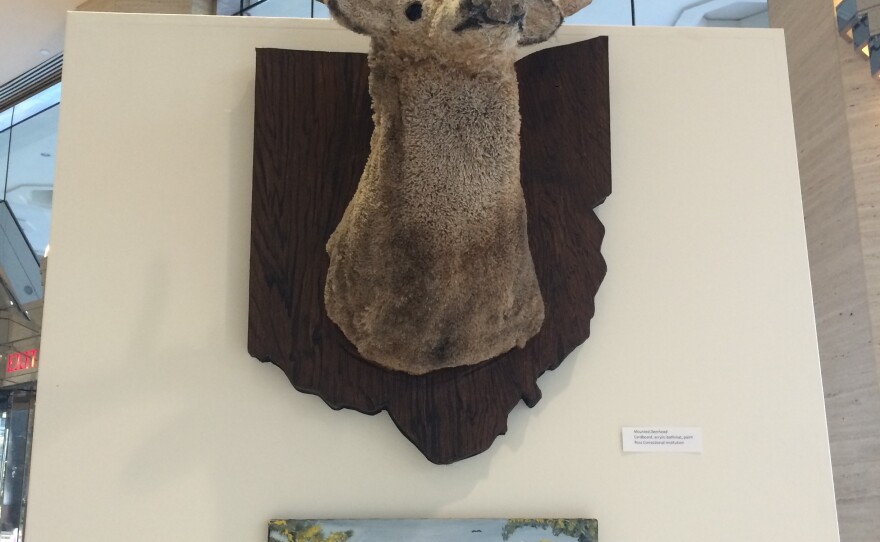For the 50,000 men and women in Ohio’s 27 prisons, time behind bars is about accepting their sentences, considering the permanent damage they’ve done to their victims and finding ways to educate and improve themselves. But some of those who are incarcerated are creating incredible works of art. And there’s a new exhibit that showcases some of the best.
Donnie Inman of Chillicothe says he always had artistic talent – even before the 31 year old ended up in the Southeastern Correctional Complex in Lancaster after coming over from the prison in Chillicothe on an eight year sentence for illegally growing marijuana. “It has been my whole life, but I didn’t not start applying it until I got to RCI [the Ross Correctional Institution]. There are some very good artists there,” Inman said. “They kept telling me how to do stuff. I would take different things from different artists and all my own skill. They told me to draw something every day. I was drawing every single day for five years.”
Among Inman's works is a very realistic 9-point buck with deep brown eyes and long lashes and delicately detailed brown fur. His painting ended up in the exhibit “Inside Looking Out: Creative Works by Ohio Prison Inmates”, which is on display across from the Statehouse in the lobby of the Vern Riffe State Office Tower where lawmakers and the governor have their offices. The inmate artwork was chosen thru regional competitions from around the state. And the works that were brought out surprised the experts brought in to judge them – one of whom is Mary Gray, director of the Ohio Arts Council’s Riffe Gallery. “I have never walked into a gallery and found a sculpture made of soap. It’s one of my favorite pieces – it’s so unique,” Gray said, describing an old-fashioned gas station scene carved from Irish Spring and carefully painted. She notes an owl with its wings outstretched – “this one is made of tongue depressors.” Another item in the exhibit – a deer head – “is made out of bath mats. It is creativity at its height. They had limited resources and they do great work with what they have.”
There’s also a model of a battleship, a wooden motorcycle and opens up and plays “Bad to the Bone”, fabric handcrafts, portraits, landscapes, and a grandfather clock. Joanna Saul is the director of the Correctional Institution Inspection Committee, a legislative office that has oversight over the prisons. “There are inmates here who are serving multiple life sentences. They have committed heinous acts, and at the same time they are capable of producing beautiful works of art. I think both things need to be recognized,” Saul said.
Some of the artists featured in the exhibition will leave prison, and Saul says their skills will serve them well during the often difficult process of re-entry into life on the outside. She points to an intricate wooden jewelry box. “There was someone who is already communicated an interest in purchasing that woodwork from the inmate once he is released,” Saul said. “It’s important to be inmate not just now about building skills prior to release, but can even aid in post-release success.”
Donnie Inman is already planning for that – he’s hoping to turn his art into a business when he’s out. He’s been making some money with his artistic skills, and that money goes home to his family, who’ve been helping him buy the equipment he’ll need to earn a living detailing cars, motorcycles and helmets with graphics and murals. “My family was proud of me. My girlfriend is really proud of me. I have a lot of people in my corner who believe in me and believe in my dreams,” Inman said. “They believe I’ll be successful when I get out of here.”
And for the all artists who won’t get ever out, Mary Gray with the Riffe Gallery says it’s important that they have their art as an outlet behind bars. She says she recently bought a large scale painting of an idyllic country road from a prisoner at the Mansfield Correctional Institution. “And I could only think of the person behind this painting knowing – this person is serving two life sentences,” Gray said. “He will never see the country road ever again. But it will never leave his imagination. And the art allows him to go to that beautiful place.”
The works in the exhibition are displayed without the artists’ names – only the facility where the inmate is housed identifies each artist, to protect victims and their survivors. The organizers hope to make this exhibit of inmate artwork an annual event.











